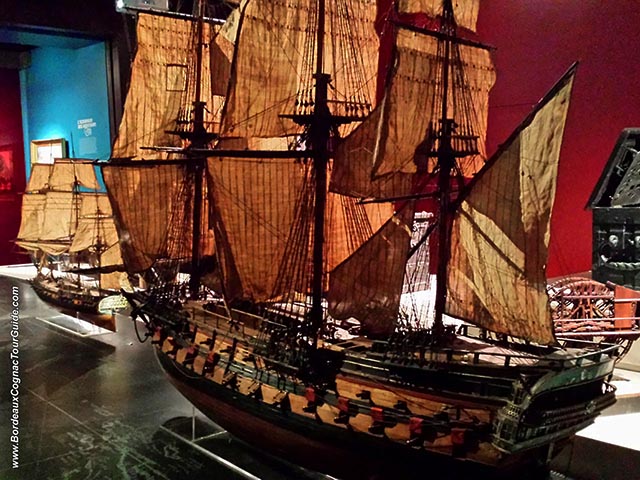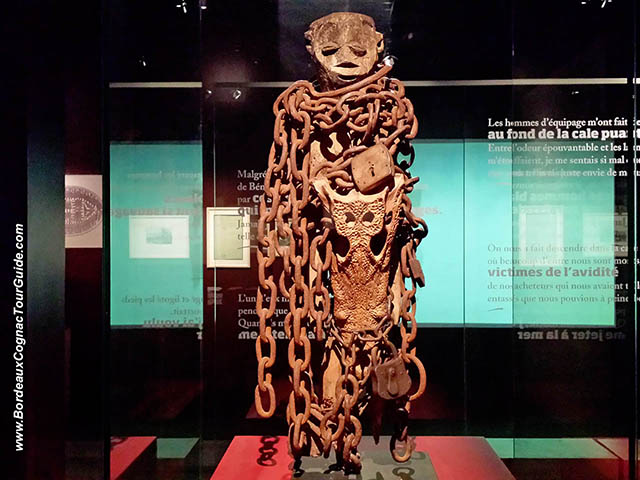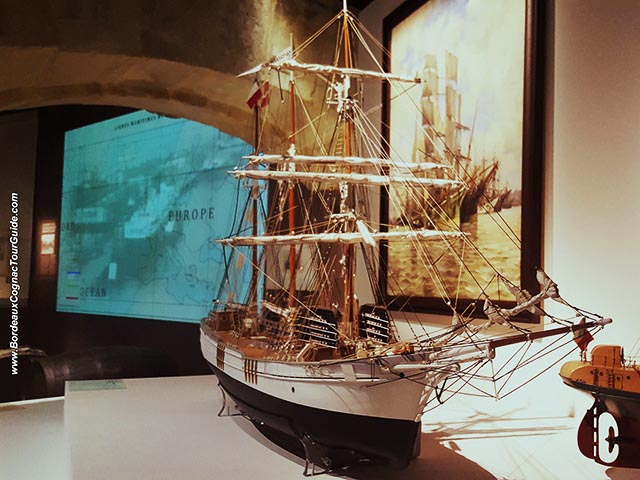My subjective selection of 4 items not to miss in the modern times section at Musee d'Aquitaine
I would like to share with you my subjective selection of works of art that should not be missed at the Musée d'Aquitaine.
Bordeaux has one of the largest provincial history museums in France. Throughout the collections, you will discover Prehistory, Antiquity, the Middle Ages, the 18th century (the golden age of the city of Bordeaux) and all the periods that made up the Aquitaine region's rich history.
For the more than acceptable amount of €5, you can join the 150,000 visitors who visit the Aquitaine Museum every year. It presents the history of Bordeaux and Aquitaine region on 2 floors, from prehistory to the present day, through a permanent collection of very varied objects.
If you trust me, I'll show you some interesting things, through a very subjective selection of meaningful items...... I chose here to focus on my 4 favorite items from the modern times section of the permanent collection at the Musée d'Aquitaine that I unroll in the chronological order of the rooms from Louis XV to our present time.
The remains of the pedestal of the monumental equestrian statue of Louis XV
 Intimately connected to the history of the Place Royale (now called Place de la Bourse), which was to serve as its setting, the equestrian statue of Louis XV arrived in Bordeaux much later than in other cities.... probably because of the strong resentment the Bordeaux people held towards the king, following the punishments that followed the revolts in 1675.
Intimately connected to the history of the Place Royale (now called Place de la Bourse), which was to serve as its setting, the equestrian statue of Louis XV arrived in Bordeaux much later than in other cities.... probably because of the strong resentment the Bordeaux people held towards the king, following the punishments that followed the revolts in 1675.
The statue transported to Bordeaux by waterways was inaugurated in 1743. The statue was dropped off its base in 1792. Preserved according to the claims of the curators of the time "in favour of the arts", it was nevertheless relegated to a hangar and then simply shipped to La Rochelle to be melted and transformed into cannons!
If the statue has disappeared, we still have the side panels to the glory of Louis xv. The two large panels were decorated with bas-reliefs sculpted by Francin, one representing the Battle of Fontenoy (11 May 1745) and the other the Capture of Port-Mahon (27 June 1756). Take the time to admire every detail because it is said that these ornaments took 2 years of work to the sculptor Francin to be completed!
There are also the magnificent trophies that were in the 4 corners of the monument, at least 3 out of 4 ! These military trophies on the corners alluded to the four parts of the world: Europe, Asia, Africa and America.
- Asia symbolized by this elephant's head and this strange beast's head...
- America symbolized by arrows, a quiver, a feather headdress and a caiman's head
- Europe with a rooster, a horse's head and this helmet that we want to see as the helmet of Alexander the Great, the great Conqueror to whom we want to compare Louis XV.
The ship model : Le Conquérant
The Conqueror, 3rd of the name, is a three-masted ship known for its longevity: 58 years of good and loyal service!  It is a ship of the line of 74 guns divided into two decks (two batteries of superposed guns) capable of carrying 650 men.
It is a ship of the line of 74 guns divided into two decks (two batteries of superposed guns) capable of carrying 650 men.
The ship of the line was designed for the naval tactic known as the line of battle, which depended on the two columns of opposing warships maneuvering to fire with the cannons along their broadsides... hence their name!
This model was made after the ship was built. It was probably made around 1770 and simplified since this model has only 64 guns.
The Conqueror was also part of all the great battles of the second half of the 18th century!
Launched in Toulon in 1746, it reached Bordeaux in 1773. The Port of the Moon is not a military port, but in times of conflict warships come to protect maritime trade.
But it was later that it would experience its greatest adventure: In 1778, Louis XVI decided to help the "American Insurgents"! The Conqueror took part in a first victorious battle off Ushant, which marked the rebirth of the French navy. In 1780, it was part of a squadron to support Lafayette on the American coast. Yeah, that's right, nothing less !
In 1782, it was found as a ship escorting a large fleet of colonial products back to Europe.
It returned to Toulon before being hastily rearmed in 1798: it was part of the "Egyptian expedition" for which Bonaparte embarked 40,000 men on 280 ships. Carelessly anchored near Abukir, the ship was surprised by Nelson's fleet. Escorted by his victors, it made his way to England where it would end his life, probably transformed into a floating prison.
Such a sad end for the story !
The fetish with real slaves chains
 Since 2009, with the creation of this part of the permanent exhibition, the city of Bordeaux has done a superb work regarding the duty of memory, evoking here one of the darkest chapters of its history: the slave trade.
Since 2009, with the creation of this part of the permanent exhibition, the city of Bordeaux has done a superb work regarding the duty of memory, evoking here one of the darkest chapters of its history: the slave trade.
Although Bordeaux has distinguished itself in the direct trade between Europe and the Caribbean, about 480 slaving expeditions from Bordeaux, the port of the Moon!
The kingdom of Dahomey (in Fon language) is an ancient African kingdom located in the southwest of present-day Benin between the 17th century and the end of the 19th century. ) Located on the Gulf of Guinea, it was one of the main centres of the slave trade from the end of the 17th century. It is estimated that nearly two million slaves were deported from European trading posts on the coast of Benin.
Among the Fon's most famous productions are Botchios, fetishes used to protect villages, lineages or individuals.
The main function of the Bocio/fetish is to get in contact with the spirits of the other world to repel harmful forces.
This Botchio, covered with authentic and very ancient slave chains and involving two crocodile skulls, is certainly unique. Its role might be related to the de-bewitchment, as underlined by the symbolism of the chains.
Items carrying slave chains are very rare because they have most often been destroyed to erase the trauma caused by slavery.
 The model of the cod fishing boat
The model of the cod fishing boat
The creation of this model required two years of work by the association Itsas Begia, whose name means "the eye of the sea"; the association works to safeguard, enhance and transmit the Basque maritime heritage. The association also makes models of authentic Basque ships. One of his models, a very fine example of a cod fishing boat, the Notre-Dame d'Uronea, is displayed in the permanent rooms of the Musée d'Aquitaine.
"Notre-Dame d'Uronea" was a traditional boat that could accommodate about thirty fishermen travelling to the banks of Newfoundland and used the small "dories", the small black boats that you see on the deck of the big sailboat.
The Banks dories were used as traditional fishing boats. They were small, open, narrow, flat-bottomed and could be stacked or nested inside each other and stored on the decks of larger fishing vessels which functioned as mother ships.
Yes, to answer a recent question asked during a guided tour of the Musée d'Aquitaine, that's why we have a tram stop in Bègles called "Terres-Neuves", since Bègles was indeed the largest cod drying centre in France during the whole of the XIXᵉ century and the first half of the XXᵉ century. Its geographical position allowed easy access to the barges and the water quality of its many streams provided the necessary resources for washing and processing cod.
Its geographical position allowed easy access to the barges and the water quality of its many streams provided the necessary resources for washing and processing cod. We therefore receive the "green" cod, simply salted to be preserved from the fishing grounds to the old world ports and then spread it over open-air lines to dry the cod.
The place was ideal for this activity: on the banks of the Garonne, Bègles offered vast areas of land, many rivers that allow the cod to be washed. Last detail: Bègles is subject to the prevailing winds which have the advantage of not bringing back the smells that could have made the bourgeoisie and the aristocracy of Bordeaux upset or even worse.... "spoil the wine"!
Enjoy your visit to the Aquitaine museum!
And don't hesitate to tell me what your favorite items in the collection are in the comments!
And click here if you've missed my subjective selection of relevant items on the ground floor and Antiquity section of the Aquitaine Museum !
Bordeaux, French history, Licensed Bordeaux tour guide, Bordeaux tourist guide, Bordeaux guided tours, Licensed Tour Guide
Terms & Conditions
Report